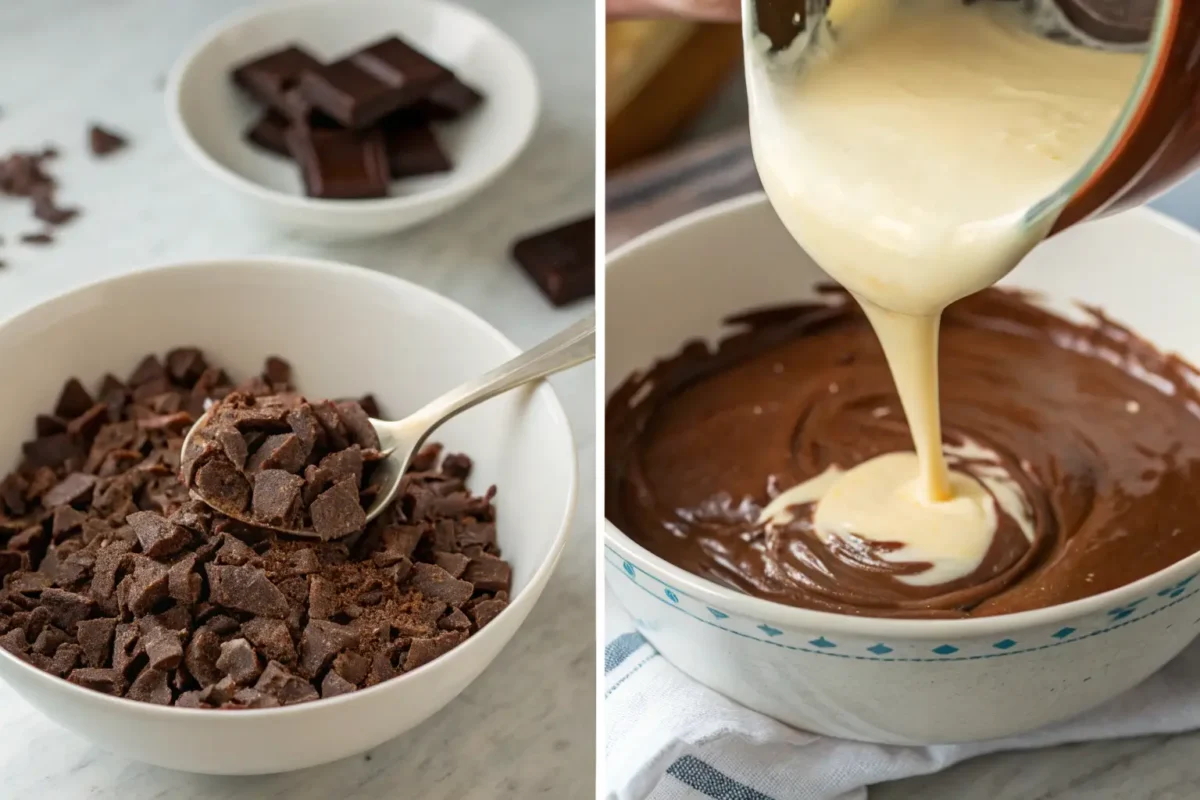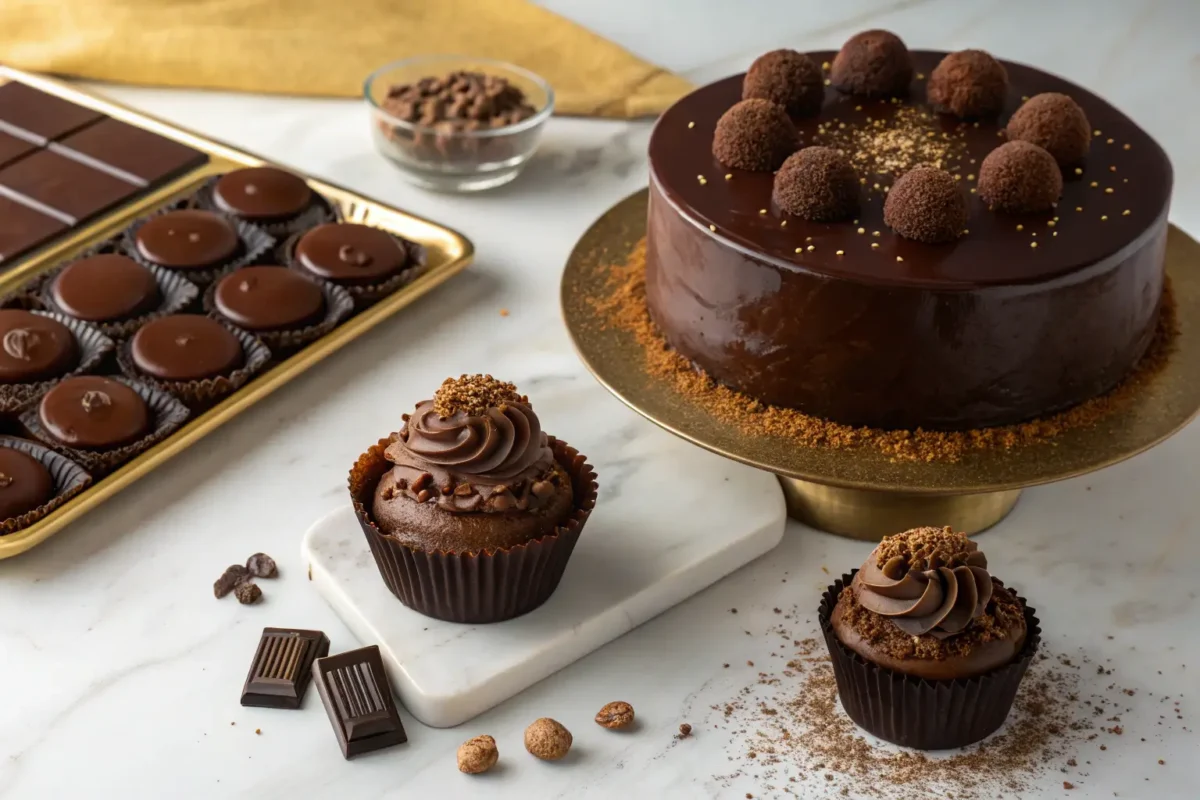If you’ve ever indulged in a silky, glossy chocolate glaze draped over a cake or a luscious truffle filling that melts in your mouth, you’ve likely encountered ganache. But what is a ganache made of? At its core, ganache is a simple yet luxurious blend of chocolate and cream, creating a rich, smooth texture used in baking and confectionery.
Despite its seemingly basic ingredients, ganache is incredibly versatile. By adjusting its consistency and ingredients, it can transform into a glaze, a filling, a frosting, or even a decadent dip. This article will take you deep into the world of ganache—its essential components, the science behind its creamy texture, creative variations, and expert tips for making it flawlessly every time.
So, if you’ve ever wondered how to achieve the perfect consistency, which type of chocolate works best, or how to create dairy-free alternatives, you’re in the right place. Let’s unravel the secrets behind this indulgent chocolate delight!
Introduction to Ganache – What is a Ganache Made Of?
What is Ganache? An Overview
Ganache is a fundamental component in the world of baking and pastry. It’s that velvety-smooth, glossy mixture found in chocolate cakes, éclairs, truffles, and tarts. But at its core, what is a ganache made of? Traditionally, it’s a simple combination of chocolate and heavy cream, blended together to create a rich, emulsified mixture.
Definition and Origins of Ganache
The word ganache comes from French cuisine, but the exact origins of this luxurious mixture are a bit of a mystery. Legend has it that a clumsy apprentice accidentally spilled hot cream onto a bowl of chocolate. Rather than discard it, the chocolatier mixed the ingredients together, resulting in the silky creation we know today. Whether or not that story is true, one thing is certain—ganache has become a staple in both professional and home baking.
The Role of Ganache in Modern Desserts
Ganache is incredibly adaptable. Depending on its chocolate-to-cream ratio, it can be used in various ways:
- Thin Ganache: Perfect as a chocolate glaze for cakes and éclairs.
- Medium Ganache: Used for cake fillings and frostings.
- Thick Ganache: Cooled and shaped into truffles. Learn more about the three types of ganache to understand its various applications.
With just two ingredients, bakers can create multiple textures, making ganache a must-know for anyone in the kitchen.
Why “What is a Ganache Made Of?” Matters to Chefs and Bakers
Many people think ganaches is just melted chocolate and cream, but its preparation requires precision and technique. Understanding what ganaches is made of helps bakers control its consistency, texture, and flavor.
Addressing Common Misconceptions About Ganaches Ingredients
- Ganache is just melted chocolate – Not true! The process of emulsification ensures a smooth, stable consistency.
- You must use dairy cream – Not true! Many bakers use alternatives like coconut cream or almond milk. If you’re looking for substitutes, check out substituting heavy cream in ganaches.
- All chocolates work the same – Wrong! The cocoa content in chocolate dramatically impacts ganaches texture and flavor.
The Cultural and Culinary Significance of Ganaches
From French patisseries to home kitchens, ganache plays a vital role in countless desserts. It elevates cakes, pastries, and confections with its luxurious, glossy texture and deep chocolate flavor. Understanding what a ganache is made of is key to mastering classic and modern dessert creations.
Exploring the Essential Ingredients of Ganache – Breaking Down “What is a Ganache Made Of?”
Ganache might seem simple at first glance, but its magic lies in the quality of its ingredients. Understanding what a ganache is made of can help you craft a silky, smooth, and flavorful mixture every time. Let’s break down the core components and optional add-ins that can elevate your ganache.
The Primary Components in Ganache: Chocolate and Cream
At its most basic, ganache is a combination of chocolate and cream. These two elements form the foundation of a smooth, velvety texture that can be used in countless ways.
Quality Chocolate: Types and Their Impact on Ganache
The type of chocolate you use determines not only the flavor but also the texture and consistency of your ganache. Here’s how different varieties affect the final product:
- Dark Chocolate (Bittersweet/Semisweet): Offers a rich, intense chocolate flavor. Ideal for a deep, indulgent ganache.
- Milk Chocolate: Creates a softer, sweeter ganache with a lighter texture. Great for fillings and frostings.
- White Chocolate: Has a creamy, buttery consistency but lacks cocoa solids. Requires a different ratio of cream for proper consistency.
When choosing chocolate, look for one with at least 60% cocoa content for dark chocolate ganache, as higher-quality chocolate results in a smoother finish.
The Importance of Cream and Its Varieties
Cream plays a crucial role in emulsifying the chocolate and determining the texture of your ganache. The type of cream you use can affect consistency:
- Heavy Cream (or Heavy Whipping Cream): Contains at least 36% fat, making it the best option for rich, stable ganache.
- Light Cream: Lower fat content means a thinner ganache, which may not set as well.
- Double Cream: Used primarily in the UK, with higher fat content than heavy cream, resulting in an extra-luxurious texture.
Additional Ingredients and Creative Variations
While the classic ganache relies on just chocolate and cream, many bakers add extra ingredients to enhance the flavor, texture, or stability.
Enhancing Ganache: Incorporating Butter, Liqueurs, and Spices
- Butter: A small amount of butter (about a tablespoon per cup of ganache) adds extra shine and richness.
- Liqueurs: Add depth and complexity—think Grand Marnier, Baileys, or Amaretto.
- Spices & Extracts: A pinch of cinnamon, sea salt, vanilla, or espresso powder can elevate the flavor profile.
Seasonal and Dietary Variations: Vegan and Dairy-Free Alternatives
Not everyone can consume dairy, but that doesn’t mean they have to miss out on ganache!
- Coconut Cream: A great substitute for heavy cream, providing a slight coconut flavor and rich texture.
- Oat Milk or Almond Milk: Works well but results in a thinner consistency. Adding cocoa butter can help stabilize it.
- Cashew Cream: Offers a creamy texture without overpowering the chocolate flavor.
By understanding what ganache is made of and how different ingredients impact its texture and taste, you can tailor it to fit any dessert or dietary need.
The Science Behind Ganache Composition – Understanding “What is a Ganache Made Of?”
Ganache isn’t just about melting chocolate into cream—it’s a delicate process of emulsification. The way these ingredients combine determines the final texture, stability, and usability of your ganache.
The Emulsification Process: How Chocolate and Cream Blend
To create a silky smooth ganache, the fat from the cream and cocoa butter in the chocolate must blend seamlessly. This is where emulsification comes in.
Temperature Control and Mixing Techniques
Getting the right texture depends on how you heat and mix your ingredients:
- Heat the Cream Properly: Bring the cream to a gentle simmer, not a rolling boil. Overheating can cause the fat to separate.
- Chop the Chocolate Finely: The smaller the pieces, the easier it will melt into the cream.
- Pour, Don’t Stir Immediately: Pour the warm cream over the chopped chocolate and let it sit for a minute before stirring. This helps ensure a smooth, even melt.
- Use Gentle Stirring Motions: Stir in small circles from the center outward to prevent air bubbles.
Optimal Ratios for a Silky Smooth Ganache
Different uses require different chocolate-to-cream ratios:
- 1:1 (Equal Parts Chocolate and Cream): The standard for classic ganache, used in glazes and fillings.
- 2:1 (More Chocolate, Less Cream): Creates a thicker consistency, perfect for truffles and sculpted decorations.
- 1:2 (More Cream, Less Chocolate): Yields a pourable ganache, ideal for sauces and drizzles.
Troubleshooting Ganache Issues
Sometimes, ganache doesn’t turn out quite right. Let’s fix the most common problems.
Overcoming Separation and Graininess
- Problem: The ganache looks grainy or separated.
- Solution: Whisk in a teaspoon of warm milk or cream to bring it back together.
- Problem: The chocolate seized up and became lumpy.
- Solution: Add a few drops of warm cream and stir gently to smooth it out.
Adjusting Ingredient Proportions for Consistency
If your ganache is too thick, add a splash of warm cream to loosen it. If it’s too thin, melt in a little more chocolate.
How to Make Ganache – Step-by-Step Guide and Techniques

Now that we’ve explored what a ganache is made of, it’s time to put that knowledge into practice. Whether you’re making a smooth glaze, a creamy filling, or rich truffles, following the right steps ensures perfect results every time.
Step-by-Step Instructions for a Classic Ganache
Creating a basic chocolate ganache is easier than you might think. Follow these simple steps for a silky, professional-quality finish.
Ingredients You’ll Need
- 8 oz (226g) high-quality chocolate (dark, milk, or white)
- 8 oz (226ml) heavy cream
- Optional: 1 tbsp unsalted butter (for extra shine)
Step 1: Chop the Chocolate Finely
Finely chopping the chocolate ensures it melts evenly when mixed with warm cream. If using chocolate chips, you can skip this step.
Step 2: Heat the Cream
In a small saucepan, warm the heavy cream over medium heat until it starts to simmer—but don’t let it boil! Boiling can cause the fat to separate, resulting in a grainy ganache.
Step 3: Combine and Let It Sit
Pour the warm cream over the chopped chocolate and let it sit undisturbed for about one minute.
Step 4: Stir Until Smooth
Using a spatula or whisk, gently stir in small circular motions from the center outward. Keep stirring until the mixture becomes silky and glossy.
Step 5: Add Butter (Optional)
For an extra-rich texture and shine, mix in one tablespoon of butter while the ganache is still warm.
Techniques for Different Ganaches Uses
Ganaches isn’t one-size-fits-all. Depending on the desired consistency, you can tweak the method slightly.
How to Make a Pourable Ganaches for Drips and Glazes
For a thin, glossy finish:
- Use a 1:2 ratio of chocolate to cream (more cream, less chocolate).
- Allow the ganache to cool slightly before pouring it over cakes or pastries.
How to Make a Thick Ganaches for Fillings and Frostings
For a pipeable, creamy consistency:
- Use a 1:1 ratio of chocolate to cream.
- Let it cool at room temperature until it thickens.
- If needed, whip the ganache with a mixer for an airy texture.
How to Make a Firm Ganache for Truffles and Sculpting
For a solid texture that can be rolled into truffles:
- Use a 2:1 ratio of chocolate to cream (more chocolate, less cream).
- Let it cool in the fridge until firm, then roll into balls and coat with cocoa powder or nuts.
With these techniques in your arsenal, you can customize Ganaches for any dessert. Now, let’s explore some creative Ganaches recipes!
Substituting Heavy Cream in Ganache – Use this when discussing non-dairy alternatives like coconut cream or oat milk.
Creative Ganaches Variations and Flavor Enhancements
Ganaches is incredibly versatile. By adding flavors, infusions, and unique ingredients, you can create custom variations that elevate your desserts. Let’s dive into some exciting ways to customize what Ganaches is made of!
Unique Flavor Infusions for Ganaches
Infusing your Ganaches with different ingredients can take its taste to the next level.
How to Infuse Ganaches with Herbs and Spices
- Heat the cream with lavender, cinnamon, cardamom, or mint leaves.
- Let the flavors steep for 10 minutes before straining the cream over the chocolate.
- Stir as usual for a subtle, aromatic Ganaches .
Adding Coffee, Citrus, and Alcohol for Depth
- Coffee or Espresso Powder: Enhances the richness of chocolate.
- Citrus Zest (Orange, Lemon, Lime): Adds a bright contrast to dark chocolate.
- Liquors and Spirits: Baileys, Kahlúa, rum, or bourbon can deepen the flavor profile.
White Chocolate and Dairy-Free Ganaches Variations
Ganaches isn’t limited to dark chocolate. Try these alternative versions for a unique twist.
White Chocolate Ganaches : A Sweeter Alternative
- White chocolate has more cocoa butter and sugar, making it softer than dark chocolate.
- Use a 3:1 ratio (more chocolate, less cream) to achieve a stable consistency.
Dairy-Free and Vegan Ganaches Options
For those avoiding dairy, try these alternatives:
- Coconut Cream: Offers a rich, slightly coconut-flavored Ganaches .
- Oat or Almond Milk: Creates a thinner, lighter version.
- Cashew Cream: Provides a smooth, creamy consistency.
Experimenting with Sweeteners and Textures
Instead of regular sugar, experiment with:
- Honey or Maple Syrup for natural sweetness.
- Nut Butters for a creamy, nutty twist.
- Crunchy Additions like crushed nuts, toffee bits, or sea salt for extra texture.
FAQs – Answering “What is a Ganaches Made Of?” and Related Queries
What is a Ganaches made of?
A classic ganache consists of just two main ingredients: chocolate and cream. The chocolate provides richness, while the cream creates a smooth, velvety texture. Depending on the ratio, Ganaches can be used for glazes, fillings, or truffles.
How does the type of chocolate affect the Ganaches ?
The choice of dark, milk, or white chocolate impacts both the flavor and texture:
Dark chocolate: Intense and rich, requiring less cream.
Milk chocolate: Sweeter and softer, needing a slightly different ratio.
White chocolate: More delicate and buttery, often requiring a 3:1 chocolate-to-cream ratio for stability.
Can I substitute cream with a non-dairy alternative?
Yes! Coconut cream is a great substitute, providing a creamy texture with a slight coconut flavor. Other options include oat milk, almond milk, or cashew cream, though they may create a thinner consistency.
What are the best practices for storing Ganaches ?
Ganaches should be stored properly to maintain its texture:
At room temperature: Up to 2 days, covered to prevent drying.
In the refrigerator: Up to 1 week, in an airtight container.
In the freezer: Up to 3 months. Thaw overnight in the fridge before use.
Why does Ganaches sometimes separate?
Overheating or incorrect mixing.
How can I thicken Ganaches ?
Add more melted chocolate or chill before use.
Conclusion – Key Takeaways on What is a Ganaches Made Of?

Ganaches is a fundamental ingredient in baking, made from chocolate and cream, with variations that allow for creativity and customization. Understanding what Ganaches is made of helps you achieve the perfect consistency, whether for a glaze, filling, or truffles.
Recap of Key Ingredients and Techniques
- Chocolate: Dark, milk, or white—each creates a different texture.
- Cream: The amount determines how thick or thin the Ganaches will be.
- Ratios: Adjusting chocolate-to-cream proportions tailors the Ganaches for various uses.
- Mixing method: Gentle stirring ensures a smooth, lump-free consistency.
Final Thoughts: Applying the Knowledge in Everyday Baking
Now that you know the essentials, you can experiment with flavor infusions, alternative ingredients, and different applications to create custom Ganaches for any dessert. Whether you’re making a rich chocolate tart, silky cake glaze, or indulgent truffles, mastering Ganaches will elevate your baking skills.






